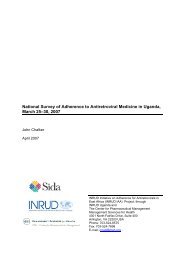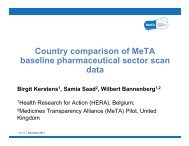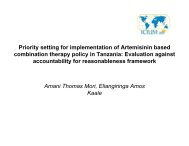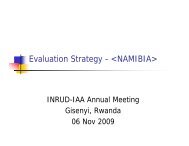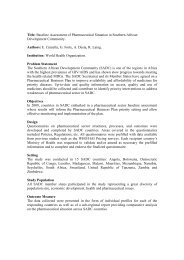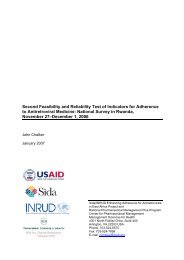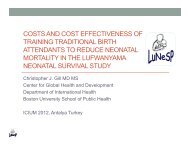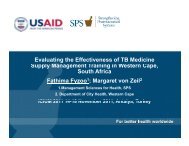How to investigate levels of Adherence to antiretroviral ... - INRUD
How to investigate levels of Adherence to antiretroviral ... - INRUD
How to investigate levels of Adherence to antiretroviral ... - INRUD
You also want an ePaper? Increase the reach of your titles
YUMPU automatically turns print PDFs into web optimized ePapers that Google loves.
Appendix 4<br />
Report template<br />
Table 4. Non-ARV key medicines that should be in s<strong>to</strong>ck in all facilities<br />
1 Cotrimoxazole tab 480 or 960 mg<br />
2 Cotrimoxazole susp 240 mg/5 ml<br />
3 Fluconazole tab 150 or 200 mg<br />
4 Miconazole gel<br />
5 Erythromycin tab 250 or 500 mg<br />
6 Nystatin oral drops 10,000 IU/ml<br />
7 Aciclovir 200 mg<br />
8 Aciclovir cream<br />
9 Folic acid 5 mg<br />
10<br />
[Select the table above with a right click, select update link.]<br />
Exit Interviews<br />
The intention was <strong>to</strong> do 30 exit interviews per facility, with the main indica<strong>to</strong>r being a selfreport<br />
on adherence in recent days. At the same time, team members collected information<br />
on other fac<strong>to</strong>rs affecting adherence, such as the time spent getting <strong>to</strong> clinic, time spent in<br />
clinic, whether medicines are accurately labelled, and whether the patient knows how <strong>to</strong><br />
take the medicine correctly. All questions were practiced in the various languages from the<br />
different regions. The definition <strong>of</strong> ‚properly labelled‛ included each medicine being in<br />
separate container or envelope with the medicine name, dose per time, and number <strong>of</strong> times<br />
per day written on it.<br />
To manage the exit interviews with the patients on ARV, when the patient went <strong>to</strong> collect<br />
their medication the pharmacist or dispenser asked them <strong>to</strong> attend an interview, provided<br />
they had not started on that exact day.<br />
Retrospective Record Review<br />
The aim was <strong>to</strong> sample 100 records from patients attending for ART during the month seven<br />
months before the month <strong>of</strong> data collection. The main purposes <strong>of</strong> the retrospective record<br />
review were <strong>to</strong>:<br />
Moni<strong>to</strong>r dispensing<br />
Follow dispensing over six months (183 days), starting from the month seven months<br />
before the month <strong>of</strong> data collection. See if there are any gaps in treatment <strong>of</strong> more than<br />
30 days and <strong>to</strong> see if the patient is still in treatment at the end <strong>of</strong> the period.<br />
133



